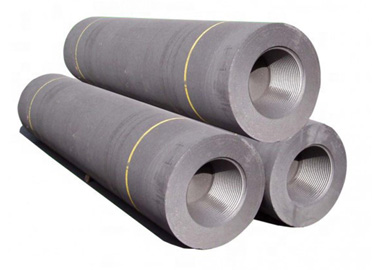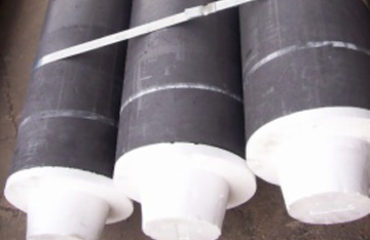
Graphite electrode, which is made of petroleum coke and needle coke as raw materials and coal tar pitch as binder, is made by calcination, batching, kneading, pressing, roasting, graphitization and machining. It is a conductor that releases electric energy in the form of electric arc to heat and melt the furnace burden. According to its quality index, it can be divided into ordinary power, high power and ultra-high power.
The graphite electrode comprises:
(1) Common power graphite electrode. Graphite electrode with current density less than 17a / cm2 is allowed to be used, which is mainly used for steel making, silicon smelting, yellow phosphorus smelting, etc.
(2) Oxidation resistant coated graphite electrode. The graphite electrode coated with a layer of anti-oxidation protective layer forms a protective layer which can conduct electricity and resist high temperature oxidation, and reduces the electrode consumption in steelmaking.
(3) High power graphite electrode. Graphite electrode with current density of 18-25a / cm2 is allowed, which is mainly used in high-power EAF for steelmaking.
(4) Ultra high power graphite electrode. Graphite electrodes with current density greater than 25A / cm2 are allowed. It is mainly used in ultra-high power EAF.
1. Wet graphite electrodes should be dried before use.
2. Remove the foam protective cap on the spare graphite electrode hole and check whether the thread in the electrode hole is complete.
3. Clean the surface of spare graphite electrode and thread in hole with compressed air without oil and water; avoid cleaning with steel wire or metal brush abrasive cloth.
4. Carefully screw the joint into the electrode hole at one end of the spare graphite electrode (it is not recommended to install the joint directly into the electrode removed from the furnace) without impacting the thread.
5. Screw the electrode sling (graphite sling is recommended) into the electrode hole at the other end of the spare electrode.
6. When lifting the electrode, put a soft object under one end of the spare electrode fitting joint, so as to prevent the ground from bumping and damaging the joint; use the hook to extend into the lifting ring of the sling to lift the electrode stably, so as to prevent the electrode from loosening from the B end or colliding with other fixed devices.
7. Lift the spare electrode above the electrode to be connected, and then drop it slowly after aligning with the electrode hole; rotate the spare electrode to make the screw hook and the electrode rotate and descend together; when the end faces of the two electrodes are 10-20 mm apart, clean the exposed parts of the two electrode ends and the joint with compressed air again; when the electrode is completely lowered, it is not allowed to be too violent, otherwise the electrode hole and electrode hole will be damaged due to violent collision The thread of the joint is damaged.
8. Screw the spare electrode with a torque wrench until the end faces of the two electrodes are in close contact (the correct connection gap between the electrode and the joint is less than 0.05mm).


